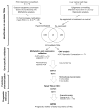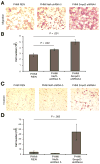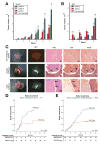Genome-wide methylation analysis and epigenetic unmasking identify tumor suppressor genes in hepatocellular carcinoma
- PMID: 24012984
- PMCID: PMC3892430
- DOI: 10.1053/j.gastro.2013.08.055
Genome-wide methylation analysis and epigenetic unmasking identify tumor suppressor genes in hepatocellular carcinoma
Abstract
Background & aims: Epigenetic silencing of tumor suppressor genes contributes to the pathogenesis of hepatocellular carcinoma (HCC). To identify clinically relevant tumor suppressor genes silenced by DNA methylation in HCC, we integrated DNA methylation data from human primary HCC samples with data on up-regulation of gene expression after epigenetic unmasking.
Methods: We performed genome-wide methylation analysis of 71 human HCC samples using the Illumina HumanBeadchip27K array; data were combined with those from microarray analysis of gene re-expression in 4 liver cancer cell lines after their exposure to reagents that reverse DNA methylation (epigenetic unmasking).
Results: Based on DNA methylation in primary HCC and gene re-expression in cell lines after epigenetic unmasking, we identified 13 candidate tumor suppressor genes. Subsequent validation led us to focus on functionally characterizing 2 candidates, sphingomyelin phosphodiesterase 3 (SMPD3) and neurofilament, heavy polypeptide (NEFH), which we found to behave as tumor suppressor genes in HCC. Overexpression of SMPD3 and NEFH by stable transfection of inducible constructs into an HCC cell line reduced cell proliferation by 50% and 20%, respectively (SMPD3, P = .003 and NEFH, P = .003). Conversely, knocking down expression of these genes with small hairpin RNA promoted cell invasion and migration in vitro (SMPD3, P = .0001 and NEFH, P = .022), and increased their ability to form tumors after subcutaneous injection or orthotopic transplantation into mice, confirming their role as tumor suppressor genes in HCC. Low levels of SMPD3 were associated with early recurrence of HCC after curative surgery in an independent patient cohort (P = .001; hazard ratio = 3.22; 95% confidence interval: 1.6-6.5 in multivariate analysis).
Conclusions: Integrative genomic analysis identified SMPD3 and NEFH as tumor suppressor genes in HCC. We provide evidence that SMPD3 is a potent tumor suppressor gene that could affect tumor aggressiveness; a reduced level of SMPD3 is an independent prognostic factor for early recurrence of HCC.
Keywords: 5-aza-2-deoxycitidine; 5-aza-2′deoxycitidine; ACTL6B; CHTN; CpG; DAC; DGKI; ELOVL fatty acid elongase 4; ELOVL4; GSTP1; HCC; LDHB; LRAT; ND; NEFH; PRPH; SMPD3; Sphingomyelin Phosphodiesterase; TSA; actin-like 6B; cooperative tissue network; cytosine preceding guanine; diacylglycerol kinase, iota; glutathione S-transferase 1; hepatocellular carcinoma; lactate dehydrogenase B; lecithin retinol acyltransferase (phosphatidylcholine−retinol O-acyltransferase); nSMase2; neurofilament, heavy polypeptide; nondiseased; peripherin; shRNA; short hairpin RNA; sphingomyelin phosphodiesterase 3; trichostatin A.
Copyright © 2013 AGA Institute. Published by Elsevier Inc. All rights reserved.
Conflict of interest statement
Conflicts of interest
The authors disclose no conflicts.
Figures





Similar articles
-
Deregulation of RB1 expression by loss of imprinting in human hepatocellular carcinoma.J Pathol. 2014 Aug;233(4):392-401. doi: 10.1002/path.4376. Epub 2014 Jun 16. J Pathol. 2014. PMID: 24838394
-
[Aberrant methylation of multiple genes and its clinical implication in hepatocellular carcinoma].Zhonghua Zhong Liu Za Zhi. 2008 Nov;30(11):831-6. Zhonghua Zhong Liu Za Zhi. 2008. PMID: 19173828 Chinese.
-
Regulator of Calcineurin 1 Gene Isoform 4, Down-regulated in Hepatocellular Carcinoma, Prevents Proliferation, Migration, and Invasive Activity of Cancer Cells and Metastasis of Orthotopic Tumors by Inhibiting Nuclear Translocation of NFAT1.Gastroenterology. 2017 Sep;153(3):799-811.e33. doi: 10.1053/j.gastro.2017.05.045. Epub 2017 Jun 2. Gastroenterology. 2017. PMID: 28583823
-
DNA methylation markers in the detection of hepatocellular carcinoma.Eur J Cancer. 2023 Sep;191:112960. doi: 10.1016/j.ejca.2023.112960. Epub 2023 Jun 28. Eur J Cancer. 2023. PMID: 37473464 Review.
-
Specific molecular signatures of non-tumor liver tissue may predict a risk of hepatocarcinogenesis.Cancer Sci. 2014 Jul;105(7):749-54. doi: 10.1111/cas.12431. Epub 2014 Jun 18. Cancer Sci. 2014. PMID: 24766251 Free PMC article. Review.
Cited by
-
DNA methylation in hepatocellular carcinoma: what is the use?Hepat Oncol. 2015 Oct;2(4):321-323. doi: 10.2217/hep.15.22. Epub 2015 Nov 6. Hepat Oncol. 2015. PMID: 30191011 Free PMC article. No abstract available.
-
Gankyrin Promotes Tumor-Suppressor Protein Degradation to Drive Hepatocyte Proliferation.Cell Mol Gastroenterol Hepatol. 2018 May 24;6(3):239-255. doi: 10.1016/j.jcmgh.2018.05.007. eCollection 2018. Cell Mol Gastroenterol Hepatol. 2018. PMID: 30109252 Free PMC article.
-
Identification of novel hypermethylated genes and demethylating effect of vincristine in colorectal cancer.J Exp Clin Cancer Res. 2014 Jan 6;33(1):4. doi: 10.1186/1756-9966-33-4. J Exp Clin Cancer Res. 2014. PMID: 24393480 Free PMC article.
-
Molecular testing on bronchial washings for the diagnosis and predictive assessment of lung cancer.Mol Oncol. 2020 Sep;14(9):2163-2175. doi: 10.1002/1878-0261.12713. Epub 2020 Jun 24. Mol Oncol. 2020. PMID: 32441866 Free PMC article.
-
Roles and regulation of neutral sphingomyelinase-2 in cellular and pathological processes.Adv Biol Regul. 2015 Jan;57:24-41. doi: 10.1016/j.jbior.2014.10.002. Epub 2014 Oct 27. Adv Biol Regul. 2015. PMID: 25465297 Free PMC article. Review.
References
-
- Ferlay J, Shin HR, Bray F, et al. Estimates of worldwide burden of cancer in 2008: GLOBOCAN 2008. Int J Cancer. 2010;127:2893–2917. - PubMed
-
- Llovet JM, Ricci S, Mazzaferro V, et al. Sorafenib in advanced hepatocellular carcinoma. N Engl J Med. 2008;359:378–390. - PubMed
-
- Villanueva A, Hernandez-Gea V, Llovet JM. Medical therapies for hepatocellular carcinoma: a critical view of the evidence. Nat Rev Gastroenterol Hepatol. 2013;10:34–42. - PubMed
Publication types
MeSH terms
Substances
Associated data
- Actions
- Actions
Grants and funding
LinkOut - more resources
Full Text Sources
Other Literature Sources
Medical
Molecular Biology Databases
Research Materials
Miscellaneous

